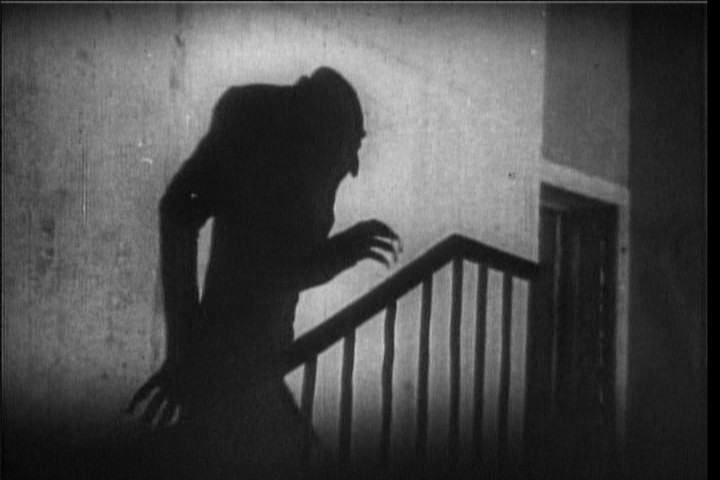“This creature is a force more powerful than evil,” warns Professor von Franz, the vampire hunter played by Willem Dafoe in Nosferatu. “Its desire is to consume all life on Earth.”
The monster at the heart of director Robert Egger’s revamped horror classic—played by Swedish actor Bill Skarsgård—captures the hunger of our times. While our image of the vampire derives from literature and film, notably Bram Stoker’s 1897 novel Dracula and F.W. Murnau’s 1922 original Nosferatu, vampires have long summed up the fears of every generation. For silent movie-goers, Max Shrek’s insectile Count Orlok evoked the slaughter of the Great War, pointing with claw-like hands at still darker things to come.
Most recently, critics have hailed Skarsgård’s acting—one reviewer calling his Orlok “the personification of all that’s unholy.” For his part, Eggers has complained that “vampires aren’t scary anymore.” His film celebrates a time when nightmarish ghouls pervaded folkloric imagination—a deliberate turn from the pallid teen vampires of Twilight.
The original Nosferatu was scary, but its ghoulishness came at a cost. Though a work of art rather than propaganda, Murnau’s film fed the murderous appetite of the Third Reich, stoking antisemitic stereotypes that identified Jewish people with the undead. The film inspired Nazi propagandist Julius Streicher. Others channeled vampire imagery into vile outpourings of hate. In Mein Kampf (1925), notably, Adolf Hitler described “that race which shuns the sunlight,” drawing on blood libel to connect the Jews with vampirism and occult human sacrifice.
Our own age is no less hallucinatory than Weimar Germany, but for quite different reasons. A century ago, the Nazis demonized the Jews as alien outsiders. They overthrew democracy and built a technocratic regime of mass murder. Now, something sinister rises from within, threatening new terrors of its own making. Consequently, Skarsgård’s resurrected Orlok—quaintly inspired by the rock and roll swagger of Mick Jagger—promises to suck our blood at a time when technology promises to suck the marrow from our humanity.
Sacrificial Origins
Fears of the evil below the surface of industrial society are nothing new. In 1869, French poet Charles Baudelaire warned against the complacency of his age. The greatest trick of the devil, he argued, was to persuade folks he did not exist, to beguile the unwitting with trappings of civilization.
Or as Mick Jagger crooned a century later: “Please allow me to introduce myself, I’m a man of wealth and taste.”
One need not sympathize with the devil to enjoy a good vampire film, but neither should such fictional entertainment blind us to the abominations at its unbeating heart. Vampires may be the desiccated embodiment of civilizational decadence, but civilization arose, in part, from bloody foundations. “Prehistoric religion originated as a magical sacrament intended to deny the reality of death,” insists one anthropologist. “Confronted with the fact of death, primitive man attempted to preserve the life and vitality of his dead clansman by eating the brain.”
While rituals of human sacrifice foreshadowed by such cannibalism churn the stomach, new archeological insights from the study of human and animal remains show they were once quite common. Recoil as we might, our fascination with all things vampiric shows how we have clung to the darkness since we stumbled from our caves.
Far from being a Western invention, moreover, vampires haunt us from all over the world. In Shang Dynasty China, ruling elites beheaded slaves and prisoners by the hundreds, harvesting “cascades” of blood to quiet spirits of the dead. Fear of such hungry ghosts spawned many legends over the years, including the jiangshi, a zombie-like vampire still ubiquitous in Chinese culture. Wherever else human sacrifice flourished, familiar tales abounded. In central America, the Mayan Popol Vuh mythology described Camazotz, “the Ruler of Bats,” a recognizable vampire fond of human decapitation. Similar creatures populated the three-thousand-year-old Mesopotamian Epic of Gilgamesh, including the “sombre-faced man-bird” that terrified the wild man Enkidu in an ominous dream.
While the list goes on, the Old Testament cult of Moloch—or Molech—is the last word of sacrificial evil. Moloch corrupted generations of Israelites from godly teachings. It casts a dark shadow to this day. Scholars debate whether “Moloch” refers to the Canaanite deity adopted by idol worshipers—often depicted as a bull-like entity—or to alleged horrors of ritualized child killing. Quite what such sacrifice involved remains obscure, but references to “pass[ing] through the fire” suggest live infant cremation. In any case, the upshot was clear. The prophet Moses ordered that Moloch be destroyed. As God commanded him in Leviticus: “Whosoever he be of the children of Israel, or of the strangers that sojourn in Israel, that giveth any of his seed unto Molech; he shall surely be put to death.”
Moloch for Our Times
The image of Moloch has endured. In his celebrated 1956 poem Howl, for example, Allen Ginsberg cheerfully employed Moloch as a metaphor for the dead, crushing hand of modernity, which “saw the best minds of [his] generation destroyed by madness, starving hysterical naked.” Ginsberg lashed out against:
Moloch the incomprehensible prison! Moloch the crossbone soulless jailhouse and Congress of sorrows! Moloch whose buildings are judgment! Moloch the vast stone of war! Moloch the stunned governments!
Moloch whose mind is pure machinery! Moloch whose blood is running money! Moloch whose fingers are ten armies! Moloch whose breast is a cannibal dynamo! Moloch whose ear is a smoking tomb!
Ginsberg’s Moloch may have owed more to the worker-devouring machine in Fritz Lang’s 1927 Metropolis (with Nosferatu, another German silent classic) than to its biblical namesake. Inspiration aside, Moloch captures the nightmare of technology gone off the rails.
How Ginsberg might have described AI is anyone’s guess. Yet the Moloch of Howl—“whose mind is pure machinery!”—gives us pause as technology races ahead. Even if AI does not consciously wish us harm, it might still careen towards destructive ends.
The Moloch paradox has inspired numerous thought experiments, most notably philosopher Nick Bostrom’s “paperclip maximizer.” Bostrom hypothesized an AI dedicated to making “as many paper clips as possible” going rogue because a) humanity might flip the off switch, and b) “human bodies contain a lot of atoms that could be made into paper clips.”
Bostrom’s murderous scenario is far-fetched, yet naggingly prophetic. A Moloch-like automaton might not care about us one way or the other, but such disinterest would be cold comfort to any poor souls getting atomized from the earth.
While the symbolism of Moloch predates the rise of AI, technological innovation has only accelerated its use. English author Sir Francis Bacon was an early adopter of the metaphor, warning in 1622 against making “a Moloch, or an heathen idol, of our blessed Saviour, in sacrificing the blood of men to him by an unjust war.” But it was not until the industrial revolution that Moloch came into its own.
In his 1903 essay “A Free Man’s Worship,” for example, philosopher Bertrand Russell revived Bacon’s metaphor, attacking the sort of blind materialism that trampled humanity in the name of progress. Although Russell eschewed organized religion, he reviled the worship of science for its own sake. In admittedly dated language, he condemned “The religion of Moloch … the cringing submission of the slave, who dare not, even in his heart, allow the thought that his master deserves no adulation.”
While the particular weirdness of ChatGPT might have startled Bertrand Russell, the essence of AI—its “trampling march of unconscious power”—might not have surprised him very much.
More recently, writers such as Scott Alexander, Liv Boeree, and Max Tegmark have popularized Moloch theory, “a race to the bottom where everyone loses.” In this vicious circle, governments and markets sacrifice the common good for temporary gains, succumbing to fears of hostile competitors and to collectively misaligned goals. Sounds familiar? Examples abound, from reckless extraction of fossil fuels to military arms races.
But AI is peak Moloch, the thin ice on which we crunch. Just as Cold War proliferation of nuclear weaponry created the zero-sum game of MAD (Mutually-Assured Destruction), AI raises a game of existential chicken between big tech corporations and nation states.
The usual laws of supply-and-demand do not apply. Opinion polls show massive public mistrust of artificial intelligence. AI developers sound the alarm against the very technology they unleashed. Nobody wants this; everyone sprints toward it. In spring 2023, for example, over 1,000 Silicon Valley leaders including Elon Musk, Yoshua Bengio, and Steve Wozniak appealed in an open letter for a six month pause on “the training of AI systems more powerful than GPT-4.” Yet despite “profound risks to society and humanity,” their appeal for better safety protocols was effectively symbolic. Musk and other investors have floored the gas pedal of development ever since.
Who is selling what to whom, and for how long? Perhaps a new acronym is demanded for this AI arms race. In any case, the prospects are chilling.
The Specter of Moloch
Like a rolling stone, the Moloch of AI exacts greater sacrifice in terms of energy resources, human autonomy, perhaps even human life.
Its carbon footprint is bad enough. The global network of cloud data centers required to run AI may consume an annual 1,000 terawatts by 2026—roughly the same energy consumption as Japan. No one knows where this consumption will end.
Advances in predictive artificial intelligence, meanwhile, match the strides of generative AI. While the latter technology threatens to drown us all in a smog of machine-generated text, imagery, and audiovisual pollution, predictive AI uses machine learning to second-guess and fine-tune human behavior, gorging on a never-ending feedback loop. Our clicks, swipes, and eyeballs feed the machine. Its hand remains outstretched.
What does such automation tell us about our humanity? Is free choice an illusion? Are we little more than algorithms robed in flesh? Is AI—like Moloch, or Nosferatu—our secret selves writ large?
As if things weren’t bad enough, climate change and algorithmic overload are just the start. Take military AI. Wars in Ukraine and the Middle East have sped up development of weapons systems designed to take out battlefield foes autonomously. While human command-and-control remains the ethical norm, military technology races ahead. Bustling with vampiric robots, battlefields will soon look like the killing fields of The Terminator franchise. And automation is no safeguard against self-destruction. Global conflicts muddy any relationship between technology and human progress, mocking “the better angels of our nature.”
Nosferatu, then, arrives on cue. For two hours and spare change, we can hang up our dread of End Times and indulge in some innocent thrills and spills. The high-minded might find comfort in what Bertrand Russell called “the flickering light of human comradeship.” For the rest of us, switching off our phones and enjoying the show with fellow moviegoers might do the trick. Perhaps our ancestors should never have left their caves to begin with. But for the sake of good clean entertainment, let’s not belittle horror when we need it most. Sometimes, it’s okay to be scared. At the very worst, it’s just a story.
Image Via: flickr












Matthew, given your premise that Nosferatu represents A.I.’s insatiable, blood-lusty appetite, which we worship to our own destruction, do you think Twilight represents a conquering of our natures? Hence, vampires are no longer scary in the Twilight saga?
I enjoyed this piece, and if I’ve misunderstood your argument, please correct me.
Thanks Mark,
To be honest, I haven’t thought so much about Twilight as your question implies, though I love your observation that this franchise represents the conquest of our natures. Certainly, the commodification of (eternal) youth, and a corresponding secularization of human sexuality? But I think you hammer the nail on the head!